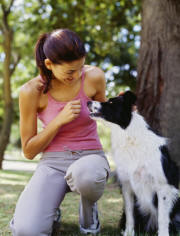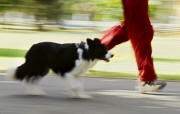Introduction
Dogs who lag behind and refuse to walk on the leash
have either never been taught the routine or have
experienced something bad such as being jerked while
on leash. In most cases, they may simply not
understand how being on leash is suppose to work.
|
The "let's go" Instruction cues
the dog to walk with you and
reminds the dog not to lag
behind. |
Slow
pokes
To
introduce puppies to a leash or to reintroduce the
leash to dogs who lag behind, try the following
technique. Begin by attaching a leash to the dog
indoors and then following the dog, praising any
movement he or she makes in any direction while on
the lead. If the dog will not move whatsoever, then,
without pulling on the leash, crouch down and act
happy, slap your knees, and try to get the dog to
come to you. If the dog does move, praise the dog
while he or she is moving along and still wearing
the leash. Give a dog cookie (i.e., food reward) as
an additional reward for coming. Once the dog is
able to do the above, back up to the length of the
leash and call the dog again.
If he or she lies down or will not come to you when
called, walk past the dog excitedly in the other
direction saying the dog's name and "Let's Go!"
as you pass by.
 If the dog follows you, praise and give a food
treat. Now, instead of crouching down again, call
the dog and back up to stimulate the natural chase
instinct and desire to get another treat! After a
few feet, stop backing up and give the dog a treat.
The dog is now walking while wearing the leash.
If the dog follows you, praise and give a food
treat. Now, instead of crouching down again, call
the dog and back up to stimulate the natural chase
instinct and desire to get another treat! After a
few feet, stop backing up and give the dog a treat.
The dog is now walking while wearing the leash.
Initially, whenever you put the leash on a reluctant
dog, make it a fun and exciting occasion. Pat
your leg and say, "Let's go" as you set off on a new
adventure with your dog. Make sure the dog
learns to associate the leash with something
wonderful such as treats, walks, quality time with
you, etc.
Attempt to make gradual progress until the dog is
easily walking on the lead. In addition, it may be
helpful to have the dog wear the leash inside the
house (while supervised) so that he or she gets used
to the feel of it.
Dogs love to "sniff
and pee" on a walk. Dogs need their walks for
physical exercise and mental stimulation. They
literally need a "change of scenery" just like we do
or they get "cabin fever." However, sniffing
every two feet can make the walk tedious for you and
limit your exercise benefit. Some sniffing ought to
be allowed or the walk is much less fun for the dog.
Sniffing is an important way that dog's explore the
environment. Walks need to allow for a moderate
amount of sniffing and urinating.
 Consider setting a limit of 4 to 6 "specials" of
sniffing and urinating during a block or for the
whole walk. After the "specials" have been used up,
if the dog tries to stop, simply keep walking. This
is when you want to cue the dog by saying, "Let's
go!"
or "Leave it,"
as you keep moving. Praise
the dog as he or she begins to pick up the pace!
Consider setting a limit of 4 to 6 "specials" of
sniffing and urinating during a block or for the
whole walk. After the "specials" have been used up,
if the dog tries to stop, simply keep walking. This
is when you want to cue the dog by saying, "Let's
go!"
or "Leave it,"
as you keep moving. Praise
the dog as he or she begins to pick up the pace!